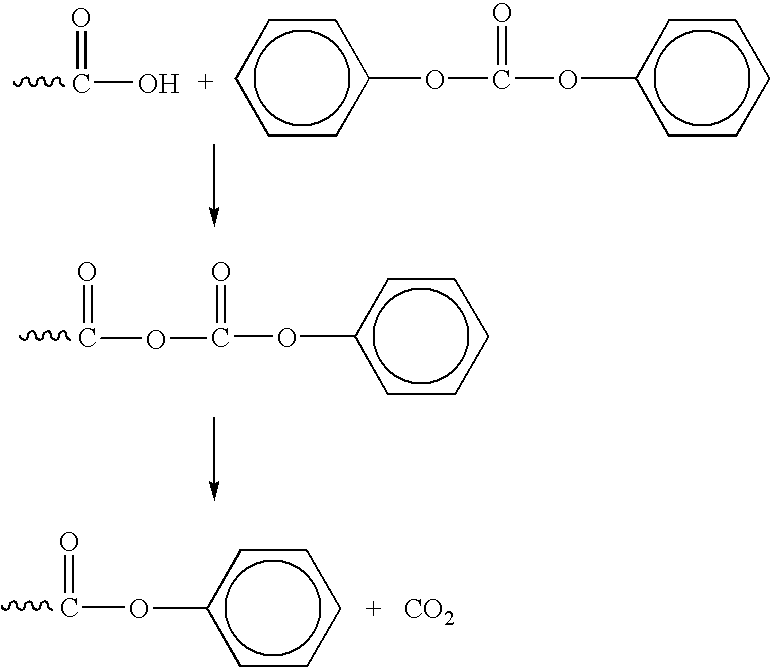Production of poly(carbonate-co-ester) copolymers
a technology of carbonate coester and copolymer, which is applied in the field of production of poly (carbonate coester) soft block copolymers, can solve the problems of difficult incorporation of low molecular weight diacid monomers and inability to be commercially viable, and achieves the effects of reducing the need for further on-site reactors, reducing the need for on-site reactors, and reducing the need for a large number of reactors
- Summary
- Abstract
- Description
- Claims
- Application Information
AI Technical Summary
Benefits of technology
Problems solved by technology
Method used
Image
Examples
example 2
The conditions and steps in accordance with Example 1 were repeated, except that a different prepolymer was initially synthesized and substituted for the polyester prepolymer Prepolymer AA prepolymer having diphenyl ester end groups was prepared from the diacid polyester prepolymer Prepolymer A (18.1 g) with DPC (8.9 g / mol). The molar ratio of the DPC to the diacid was 3:1. The reaction was conducted at a temperature of 220.degree. C. under 1 atm of nitrogen and used TMAH as a catalyst in a molar ratio of 4.25.times.10.sup.-6 with respect to the diacid. After a one hour reaction time, the diphenyl ester capped prepolymer was purified by vacuum distillation to remove the phenol byproduct. The structure of the diphenyl ester capped prepolymer was confirmed by NMR.
The synthesized diphenyl ester (1.05 g), DPC (25.1 g, 0.117 mol) and BPA (24.9 g, 0.109 mol) were charged together under the conditions as given in Example 1 (omitting the prereaction of diester, DPC and BPA, as previously no...
example 3
The monomers DPC (25.0 g; 0.116 mol) and BPA (24.5 g; 0.107 mol) were charged together with the diacid polyester prepolymer Prepolymer A (1.42 g). TMAH and NaOH served as catalysts and were added to the reaction mixture as an aqueous solution (100 .mu.L) in the molar ratios of 2.5.times.10.sup.-4 for TMAH and 1.5.times.10.sup.-6 for NaOH relative to BPA. The polyester prepolymer and DPC and BPA monomers were first prereacted for one hour at 230 degrees Celsius under nitrogen at atmospheric pressure. Then the polymerization reaction was conducted under increasing temperature and decreasing pressure as a function of time according to the following reaction profile in Table 3:
[t3]
The reaction was quenched and the product purified and analyzed as in Example 1. The glass transition temperature (T.sub.g) of the copolymer product was determined by DSC to be 128.degree. C. The molecular weight Mw was determined to be 4.14.times.10.sup.4 g / mol via GPC using a 1 mg / ml polymer solution in meth...
example 4
The monomers DPC (25.0 g; 0.116 mol) and BPA (24.4 g; 0.107 mol) were charged together with the diacid polyester prepolymer Prepolymer A (2.36 g). TMAH and NaOH served as catalysts and were added to the reaction mixture as an aqueous solution (100 .mu.L) in the molar ratios of 2.5.times.10.sup.-4 for TMAH and 1.5.times.10.sup.-6 for NaOH relative to BPA. The polyester prepolymer and DPC and BPA monomers were first prereacted for one hour at 230 degrees Celsius under nitrogen at atmospheric pressure. The polymerization reaction was conducted according to the following reaction profile in Table 3 and quenched, purified and analyzed as detailed in Example 1. The glass transition temperature (T.sub.g) of the copolymer product was determined by DSC to be 111.degree. C. The molecular weight Mw was determined to be 4.16.times.10.sup.4 g / mol via GPC using a 1 mg / ml polymer solution in methylene chloride versus polystyrene standards. Proton and carbon NMR of the purified polymer confirmed th...
PUM
| Property | Measurement | Unit |
|---|---|---|
| Percent by mass | aaaaa | aaaaa |
| Percent by mass | aaaaa | aaaaa |
| Pressure | aaaaa | aaaaa |
Abstract
Description
Claims
Application Information
 Login to View More
Login to View More - R&D
- Intellectual Property
- Life Sciences
- Materials
- Tech Scout
- Unparalleled Data Quality
- Higher Quality Content
- 60% Fewer Hallucinations
Browse by: Latest US Patents, China's latest patents, Technical Efficacy Thesaurus, Application Domain, Technology Topic, Popular Technical Reports.
© 2025 PatSnap. All rights reserved.Legal|Privacy policy|Modern Slavery Act Transparency Statement|Sitemap|About US| Contact US: help@patsnap.com



